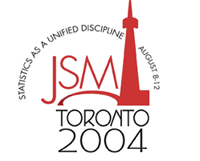|
Activity Number:
|
326
|
|
Type:
|
Topic Contributed
|
|
Date/Time:
|
Wednesday, August 11, 2004 : 10:30 AM to 12:20 PM
|
|
Sponsor:
|
ENAR
|
| Abstract - #300595 |
|
Title:
|
Picking the Most Likely Candidates for Further Development: Novel Intersection-union Tests for Addressing Multicomponent Hypotheses in Comparative Genomics
|
|
Author(s):
|
David B. Allison*+
|
|
Companies:
|
University of Alabama, Birmingham
|
|
Address:
|
Ryals Public Health Bldg., Suite 327, Birmingham, AL, 35294-0022,
|
|
Keywords:
|
microarrays ; target identification ; intersection union tests ; RNAi ; Bayesian ; Frequentist
|
|
Abstract:
|
In selecting genomic targets and physiological pathways for future study or drug development, investigators select a subset of candidates from among many options. In prioritizing, they may seek potential targets that meet all of several criteria--e.g., genes that are differentially expressed in response to a particular stimulus in each of several species (i.e,. evolutionarily conserved responses), or genes that are differentially expressed in response to a stimulus and also produce a predicted phenotypic change when knocked down in with RNAi. Testing whether several (k) null hypotheses can all be rejected requires intersection-union tests (IUTs). A traditional IUT rejects the union of all k null hypotheses in favor of the intersection of all k alternative hypotheses if a test for every one of the separate k null hypotheses is rejected. This IUT is generally conservative. Moreover, it yields results classifiable as significant or not, but not a quantitative p-value. Herein, we examine an approach to frequentist testing to overcome these limitations. We then present a Bayesian approach to the problem that makes more effective use of data when many IUTs are conducted simultaneously.
|
- The address information is for the authors that have a + after their name.
- Authors who are presenting talks have a * after their name.
Back to the full JSM 2004 program |
